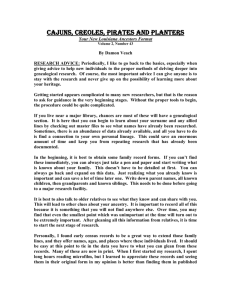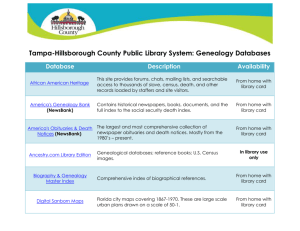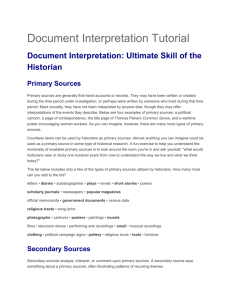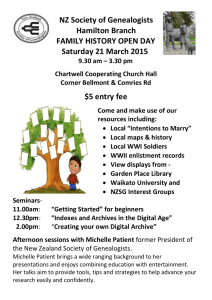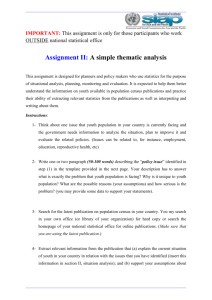Genealogists and Social Researchers
advertisement
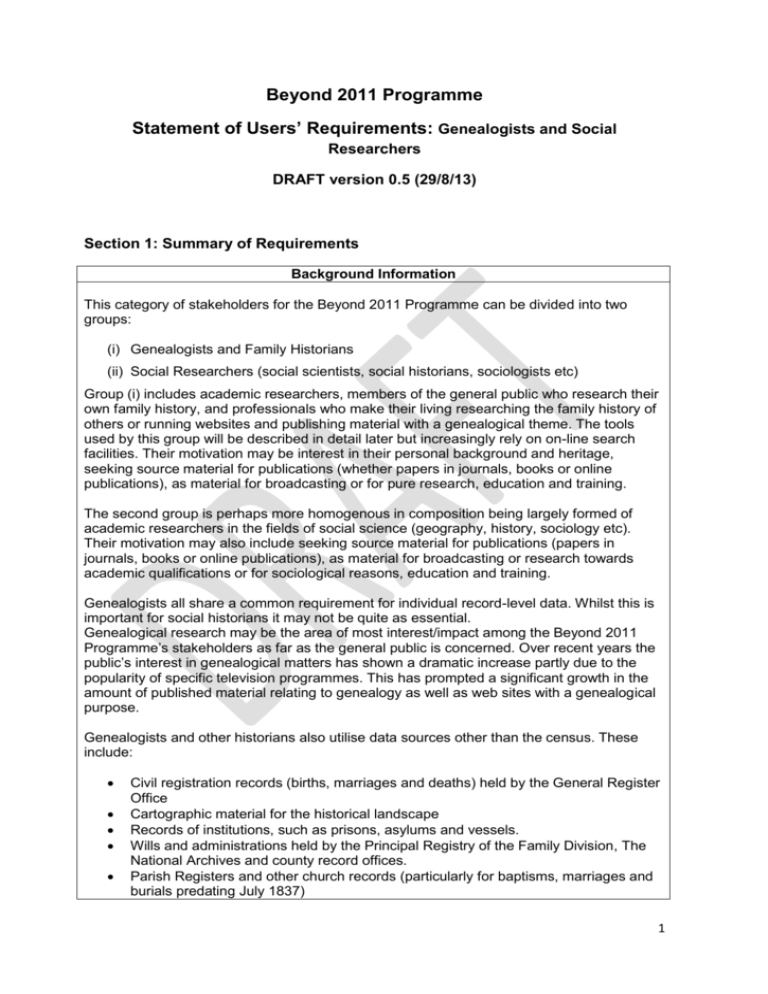
Beyond 2011 Programme Statement of Users’ Requirements: Genealogists and Social Researchers DRAFT version 0.5 (29/8/13) Section 1: Summary of Requirements Background Information This category of stakeholders for the Beyond 2011 Programme can be divided into two groups: (i) Genealogists and Family Historians (ii) Social Researchers (social scientists, social historians, sociologists etc) Group (i) includes academic researchers, members of the general public who research their own family history, and professionals who make their living researching the family history of others or running websites and publishing material with a genealogical theme. The tools used by this group will be described in detail later but increasingly rely on on-line search facilities. Their motivation may be interest in their personal background and heritage, seeking source material for publications (whether papers in journals, books or online publications), as material for broadcasting or for pure research, education and training. The second group is perhaps more homogenous in composition being largely formed of academic researchers in the fields of social science (geography, history, sociology etc). Their motivation may also include seeking source material for publications (papers in journals, books or online publications), as material for broadcasting or research towards academic qualifications or for sociological reasons, education and training. Genealogists all share a common requirement for individual record-level data. Whilst this is important for social historians it may not be quite as essential. Genealogical research may be the area of most interest/impact among the Beyond 2011 Programme’s stakeholders as far as the general public is concerned. Over recent years the public’s interest in genealogical matters has shown a dramatic increase partly due to the popularity of specific television programmes. This has prompted a significant growth in the amount of published material relating to genealogy as well as web sites with a genealogical purpose. Genealogists and other historians also utilise data sources other than the census. These include: Civil registration records (births, marriages and deaths) held by the General Register Office Cartographic material for the historical landscape Records of institutions, such as prisons, asylums and vessels. Wills and administrations held by the Principal Registry of the Family Division, The National Archives and county record offices. Parish Registers and other church records (particularly for baptisms, marriages and burials predating July 1837) 1 Collections kept at county record offices, such as rate books, poor law records, Land Tax records and the archives of local land or estate owners Oral history DNA analysis Key Uses and Requirements The census data currently used by genealogists are the household schedules completed for the censuses that took place every ten years from 1841 to 1911 (this detail in more recent censuses is closed to researchers). The most useful census data currently available for use by family historians is: Full forenames and family names of individuals Address of named individuals Sex of named individuals Marital status of named individuals Age of named individuals Full birthplace of named individuals Occupation of named individuals Family relationships Some of the above fields differ from those used by the 2011 census. The following key changes to the details collected in 2011 are felt necessary to meet the needs of future family historians: Names of individuals – these should include all forenames, maiden name (where relevant) and the family name. This will greatly assist in positively identifying individuals with relative common “first & family name” combinations. Place of birth – this should include the name of the (1) village, town or city, (2) county or local equivalent and (3) country. Such details would assist in positively identifying individuals and also help the descendants of relatively recent immigrants to this country to focus on the accurate place of origin when seeking to discover more about their heritage. This dimension is of growing significance as people born abroad form an increasing proportion of the contemporary population. Of lower importance, but still desirable for family history research would be: the number of children within marriages/partnerships family relationships With the changing nature of relationships in an increasingly diverse population it would also be of benefit to have a way of capturing data on relationships that do not fit into traditional or established patterns (such as same-sex or cohabiting relationships). Increasingly the requirement for historical data is at smaller geographical areas as there is a growing demand for information about housing stock and the division of streets into separate properties/households. Division by post-code geography would probably meet future research needs. This reflects an increasing requirement for historians and 2 genealogists to reconstruct historic communities. Data on people living in communal establishments is also a key requirement as it enables historians to see social change evolving as housing units develop over time. This data would provide information on how long individuals had been living in a communal establishment among other things. Key Uses Information on full names, place of birth and ‘geographical root’ is essential for genealogists, as is date of birth. Apart from the primary requirement of data to enable the recreation of family history (this idea has been expressed in the term ‘family gatekeeper’), uses include: Development of genealogical issues in educational programmes Reconstruction of historic communities for sociological purposes Detailed socio-economic information about the country’s past Tracing disability and disease through family history Tracing patterns of migration within families or communities Genealogical material is increasing in popularity all the time with the result that there is an exponential growth in the number of genealogical publications and websites with a genealogical theme. Key uses of census data for social historians were explored by the House of Commons Science and Technology Committee on ‘The Census and Social Science’ The report of the Committee noted that ‘ONS must be sure that the tools used to collect data will be adequate. One key concern is that we have not identified any dataset that will really enable social scientists/historians to follow individuals over time. Most public sector data-gathering is focused on the size of specified groups, rather than details of individuals, and private sector databases (such as those for loyalty cards) cover only parts of the population...’ The Committee went on to add that: ‘The regular conduct of a census in the UK has provided … social scientists with an almost unique dataset with which to examine the changing nature of UK society over the past 200 years. …the Government needs to ensure future access to high quality social data.’ The evidence presented to the Committee by Dr Peter King and Professor Edward Higgs stressed that census was extremely important as a data source and that work currently underway to integrate census datasets would allow the study of subjects such as social and physical mobility, the life courses of the disabled, the intergenerational experience of migrant families and many other subjects. Individual-level records are a vital source for this work because they permit the location of individuals spatially, socially (by family and occupational strata) and temporally. The availability of individual record-level data is also very important as it allows historians to link the census returns with other nominal records which allows them to deepen their understanding of individual circumstances in the past. 3 Section 2: Uses of genealogical study Current or anticipated future uses Family history has grown in popularity and complexity during the past 40 years. Before the 1970s relatively few people were engaged in it. They tended to be drawn from the more affluent section of the population, often focussing on connections with prominent families and individuals. The period between 1970 and 1980 was marked by a substantial increase in the numbers and diversity of family historians, accompanied and served by a growing number of local family history societies and publications. There was a major “democratisation”, both of the researchers and of the researched. The advent of the internet has vastly increased the availability of family history resources and opportunities for researchers to co-operate on a global scale. Personal websites and epublishing are just two of the relatively new means by which discoveries can now be made available to the world at large at relatively modest cost or risk. Spurred on by TV programmes and other media interest, the numbers involved in family history research and writing continue to increase. Despite the arrival and growth of major commercial organisations in the family history world, a strong volunteer ethos continues to flourish, both at an individual level and in the not-forprofit activities of family history societies and the Church of Jesus Christ of Latter-day Saints. Aspects of family history that are likely to expand substantially during the next few years include: Crowd-sourcing, especially for indexing projects “Print on demand” as a means of producing books in paper format Scanning and free distribution online of out-of-copyright books DNA analysis to confirm or challenge biological connections between particular individuals and groups Ancestry-related tourism by those who, having discovered where their forebears used to live, decide to visit in person. Details of ongoing requirements for specific census variables Full forenames, maiden names and family name of individuals Address of named individuals Sex of named individuals Marital status of named individuals Date of birth of named individuals Full birthplace of named individuals Occupation of named individuals Family relationships 4 Section 3: Availability of Alternative Information Certain data sources other than census and traditional sources are already used to recreate the historical record. These include: Telephone directories Electoral rolls School enrolment records In addition genealogists might make greater use in future of a much wider range of data sources to supplement existing ones including: Higher Education records DVLA data Child Benefit records Midwives records Work and pensions data However there are, as yet, unanswered questions about whether these data sources would be retained over time and whether individuals would have a right to access them. Also these sources seldom provide the same degree of context and universality as the Census schedules. The key feature of Census schedules and statistics has been to provide a broad framework for linking individual, family, household and community information from other sources. Current developments in technology and the internet mean that genealogists and historians will probably investigate the use of alternative sources for data. Although these sources may be useful they will not, by their nature, be alternatives to the data from a census. These may include: DNA analysis Social Media (such as Facebook and Twitter) Community records and archives ‘Internet shadow’ of individuals Digitised connectivity between different sources The current, increased, level of interest in genealogy means that in the future a large number of people will already be aware of and linked up with genealogical concerns. This also makes it very likely that the sources used as genealogical data and the ways in which this can be transmitted and manipulated will continue to grow. None of the alternative sources of information mentioned above match the primary merit of the Census as a “universal snapshot” of almost everyone present in the country at a particular time. 5
